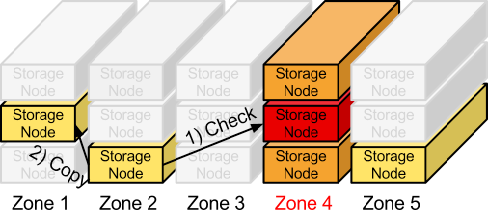In order to ensure that there are three copies of the data everywhere, replicators continuously examine each partition. For each local partition, the replicator compares it against the replicated copies in the other zones to see if there are any differences.
The replicator knows if replication needs to take place by examining hashes. A hash file is created for each partition, which contains hashes of each directory in the partition. Each of the three hash files is compared. For a given partition, the hash files for each of the partition's copies are compared. If the hashes are different, then it is time to replicate, and the directory that needs to be replicated is copied over.
This is where partitions come in handy. With fewer things in the system, larger chunks of data are transferred around (rather than lots of little TCP connections, which is inefficient) and there is a consistent number of hashes to compare.
The cluster eventually has a consistent behavior where the newest data has a priority.
If a zone goes down, one of the nodes containing a replica notices and proactively copies data to a handoff location.


